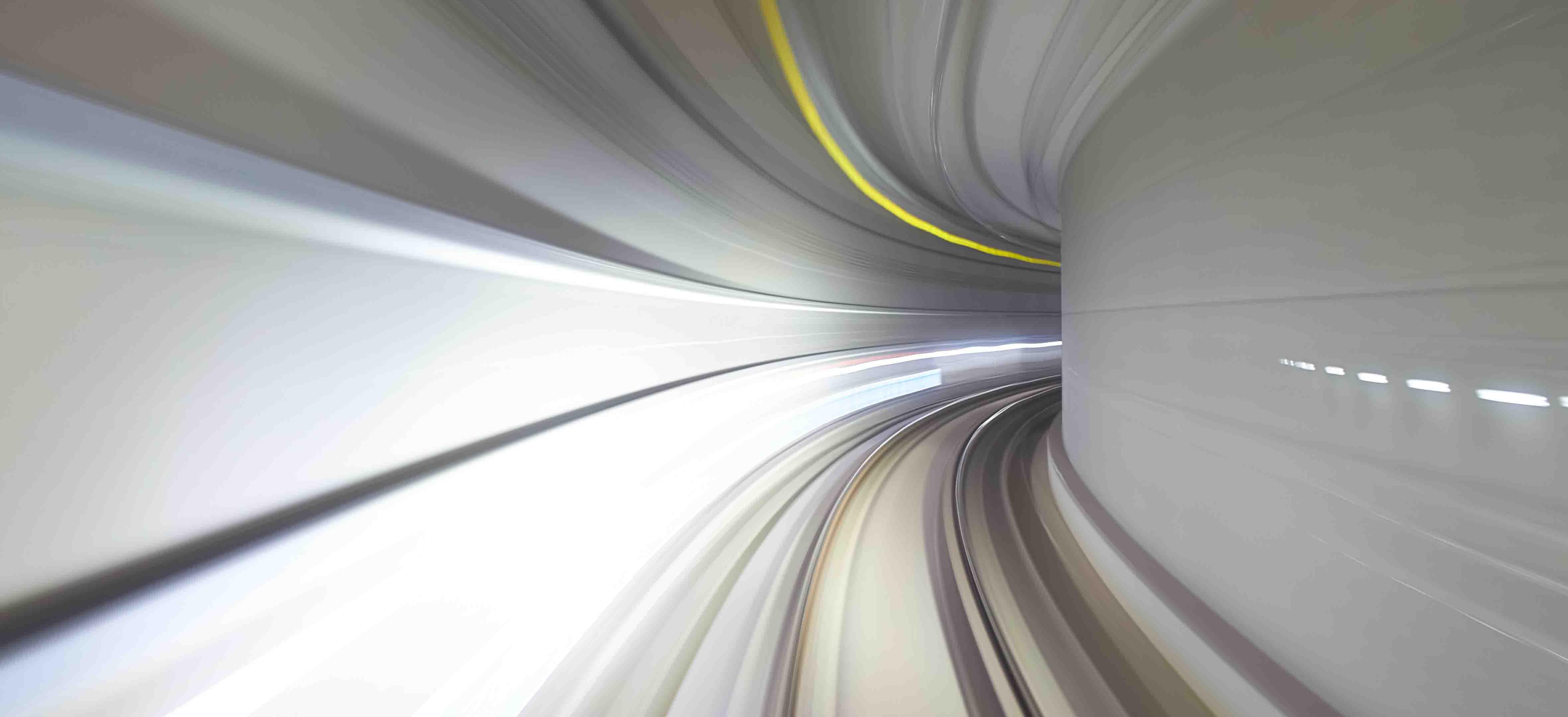An exploratory study commissioned by the Flemish Agency for Innovation and Entrepreneurship (VLAIO)
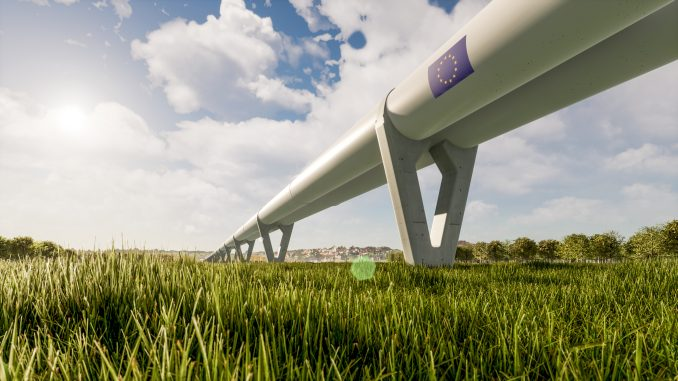
This notion provides an overview of a study commissioned by VLAIO (Agency for Innovation & Entrepreneurship Flanders), which examines the potential and status of the hyperloop as a transportation concept. The study delves into various aspects of the hyperloop, including its capability for passenger and cargo movement, the required infrastructure and logistics, impacts, legal barriers, and relevant policy recommendations for Flanders. The primary goal of the research is to deliver an all-encompassing comprehension of the hyperloop idea, the obstacles it faces, and its possible benefits. Additionally, it seeks to pinpoint the crucial areas where Flanders could play a significant role in fostering the growth of this technology.
Overview of current academic insights
The following insights present the findings of a literature analysis and expert viewpoints on the potential and status of hyperloop as a transportation concept:
- Most publications focus on the use of hyperloop for passenger transportation. However, recent studies increasingly acknowledge hyperloop's potential for cargo transportation as well.
- The literature suggests that several questions remain unanswered concerning safety, operational costs, and regulatory frameworks. The precise socioeconomic prerequisites needed to justify the high tunneling, implementation, and operational costs of hyperloop are still unclear. Hence, further research is necessary before hyperloop systems can be commercialized.
- Estimates from pre-feasibility studies show that the construction costs of hyperloop systems range from €24.3 to €91.7 million (underwater tunnel) per km. However, these are early estimates. Industry experts and academics agree that the early technological status of hyperloop does not allow for precise estimation of maintenance costs yet.
- The hyperloop can offer time savings, emission reduction, and other socioeconomic benefits. Commercialization of a hyperloop route can also contribute to reducing traffic congestion and mitigating negative external effects of other modes, such as noise or accidents. Depending on individual routes, these benefits must be estimated in detail. This report provides an initial estimation of several benefits of a Flemish hyperloop route.
- The literature demonstrates that hyperloop systems can influence existing transport modes and socioeconomic situations. Although the hyperloop is suitable for areas up to 1,500 km apart, shorter connections (300-500 km) can also be valuable. The primary focus is proposing hyperloop connections where the existing transport capacity seems currently saturated. The hyperloop can play a significant role as a substitute or addition to rail connections, and in consolidating the hub role of major (air)ports.
- The literature shows that, given the pods' capacity (and the payload in the case of cargo transportation) is relatively low, hyperloop's potential as a mass transit system lies mainly in its ability to achieve very high speeds with very frequent departure intervals.
- Initiatives focused on cargo transportation explore, among other things, the potential of hyperloop in connecting seaports with their hinterland, as well as in the transportation of valuable goods, for which speed is important. For the transport of sea containers, tubes with a large diameter are required. Other types of goods (e.g., parcels, valuable items, etc.) can use the same tube infrastructure and pods as passengers.
Implementation
To achieve commercial realization of the hyperloop concept, several milestones need to be achieved. These are:
- Development of hyperloop technology components: The hyperloop concept combines proven and new technological elements. All components must reach an adequate 'Technology Readiness Level' (TRL) for commercialization.
- Social acceptance of hyperloop: Widespread hyperloop adoption requires not just technological development, but also broad public acceptance.
- Standardization and regulation of hyperloop: The implementation of hyperloop at the European level necessitates the development of technological standards and a stable regulatory framework.
- Planning and feasibility evaluation: Implementing a hyperloop route requires a thorough evaluation of its economic, technical, and spatial feasibility. This report provides a high-level evaluation of a potential hyperloop route in Flanders.
Development of hyperloop technology components
The maturation of the hyperloop system is guided by the Technology Readiness Level (TRL), a scale from 1 to 9. Three distinct stages with corresponding test facilities are needed to reach TRL 8:
- Full-Scale Low Speed Test Facility: This facility is designed to validate all key sub-components at full scale but at slow speeds, such as levitation, guidance, and propulsion systems.
- High-Speed Test Facility: These facilities have a minimum length of 3-4 km and are used to validate hyperloop technologies at high speeds, aiming to reach TRL 6.
- Pilot Route: This phase serves to demonstrate all developed technologies in an operational environment. The pilot route, ideally located in a corridor of a potential route, is used to validate the technology on a larger scale (TRL 7) and then, after certification and approval by competent authorities, to reach TRL 8.
Once the pilot route is expanded into the first commercial route, TRL 9 is achieved, indicating the system's proof in an operational and commercial environment.
Social acceptance of hyperloop
Technological innovation adoption is not solely reliant on technological advancement but also societal acceptance. As such, research and innovation processes must consider public perception throughout their development.
The report introduces the concept of 'Societal Readiness Level' (SRL), a gauge for societal acceptance of a technology or product. Developed analogously to the TRL, the SRL scale ranges from SRL 1 (identifying a societal problem) to SRL 9 (successful deployment in real-world context). Both SRL and TRL evaluations happen simultaneously.
Passenger acceptance is essential for societal adoption. It requires researching passenger needs and concerns, which can be done using digital prototyping in AR or VR environments that simulate the full hyperloop experience. Successful completion of this leads to SRL 6 .
Non-passenger acceptance, or societal acceptance as a whole, is also essential. It involves addressing issues such as spatial planning and understanding the hyperloop's environmental impact and noise level. Public concerns around hyperloop technology can be mitigated by demonstrating safe and reliable cargo transportation in a High-Speed Test Facility. If successful, it results in SRL 7. Demonstrating safe and efficient passenger transportation would then lead to SRL 8. Finally, opening and operationalizing the first commercial route will achieve SRL 9.
Building blocks of the hyperloop concept
The successful implementation of the hyperloop concept requires expertise in various elements, as highlighted in the VLAIO report. Groundworks, pylons, foundation, tunnel building, spatial planning, stations, and solar panels are crucial for the construction of the hyperloop, while logistics and operations require management software, transport units and cargo handling, cross-border management, maintenance, and safety.
The study emphasizes the importance of standardization and automation of cargo and baggage transport units, loading and unloading systems, and the use of composite materials to maximize payload. It also recommends the creation of a pooling system for standardized transport units and efficient processes and management across borders, along with cargo and passenger pod maintenance and safety.
Efficient systems to create and maintain a vacuum over large volumes are necessary to reduce operational costs, and a deep understanding of air freight processes is necessary for system optimization and integration, given the hyperloop network's primary connections between airports and cities. Integration of network nodes also requires interconnectivity through data exchange platforms.
Overall, the successful implementation of the hyperloop concept demands a high degree of expertise, standardization, and automation in construction, logistics, and operations, along with a deep understanding of air freight processes, efficient systems, and interconnectivity.
Flanders ecosystem for hyperloop concept
Industry
Flanders, Belgium is home to a variety of industries that could play significant roles in the development and implementation of the hyperloop concept.
- Core Technology: Flanders has a strong steel industry that can contribute to the production, finishing, transport, and installation of the steel tubes needed for the hyperloop concept. It also has businesses that specialize in areas such as airlocks, air pumps, and gate valves necessary for maintaining vacuum conditions in the tubes. The region also has companies with expertise in the production of magnets and magnetic rails, which may be used for the propulsion of hyperloop vehicles.
- Vehicle Manufacturing: Flanders boasts a range of businesses skilled in the use of composite materials, which could be used to create the vehicles or "pods" of the hyperloop system. These companies have expertise in various areas, including aerospace technology, visualization, and interior design, which could be important for creating an appealing and comfortable passenger experience.
- Construction: Flanders has a robust construction sector with a range of companies that could be involved in the groundwork, the creation of pylons and foundations, and tunnel construction necessary for a hyperloop system. This sector also includes companies that specialize in the construction of stations and the spatial planning of the hyperloop track.
However, certain components such as expansion joints and switches, along with the capability to manufacture innovative solar panels, are areas where Flanders currently lacks distinct expertise.
In summary, while Flanders does not have any companies currently contributing to the development of the hyperloop, its rich industrial ecosystem offers significant potential for future involvement in this innovative transportation concept.
Academic Institutions
Academic institutions, especially universities, are central to the evolution of hyperloop technology across Europe. Many European hyperloop organizations initially sprouted from university-led initiatives. Often, these started as technical projects where students and researchers collaborated to create hyperloop technology components for the SpaceX's international competition.
Over time, these university-based initiatives often morphed into independent businesses dedicated to hyperloop technology. Thanks to their academic roots, these enterprises continue to benefit from ongoing financial and technological assistance from their originating institutions and interested industry partners.
In Flanders, a rich landscape of research groups with relevant expertise exists, spanning core technology, construction, spatial planning, logistics, and operational elements. However, specific academic research into the technological and socioeconomic facets of the hyperloop concept is currently absent in this region.
For an analysis of research projects view VLAIO study.
Mapping of opportunities for Flanders
This section examines the current status and potential for the hyperloop in the Flanders. The section utilizes a matrix to map 'space for technological development' and 'Flemish expertise', this can be seen below.
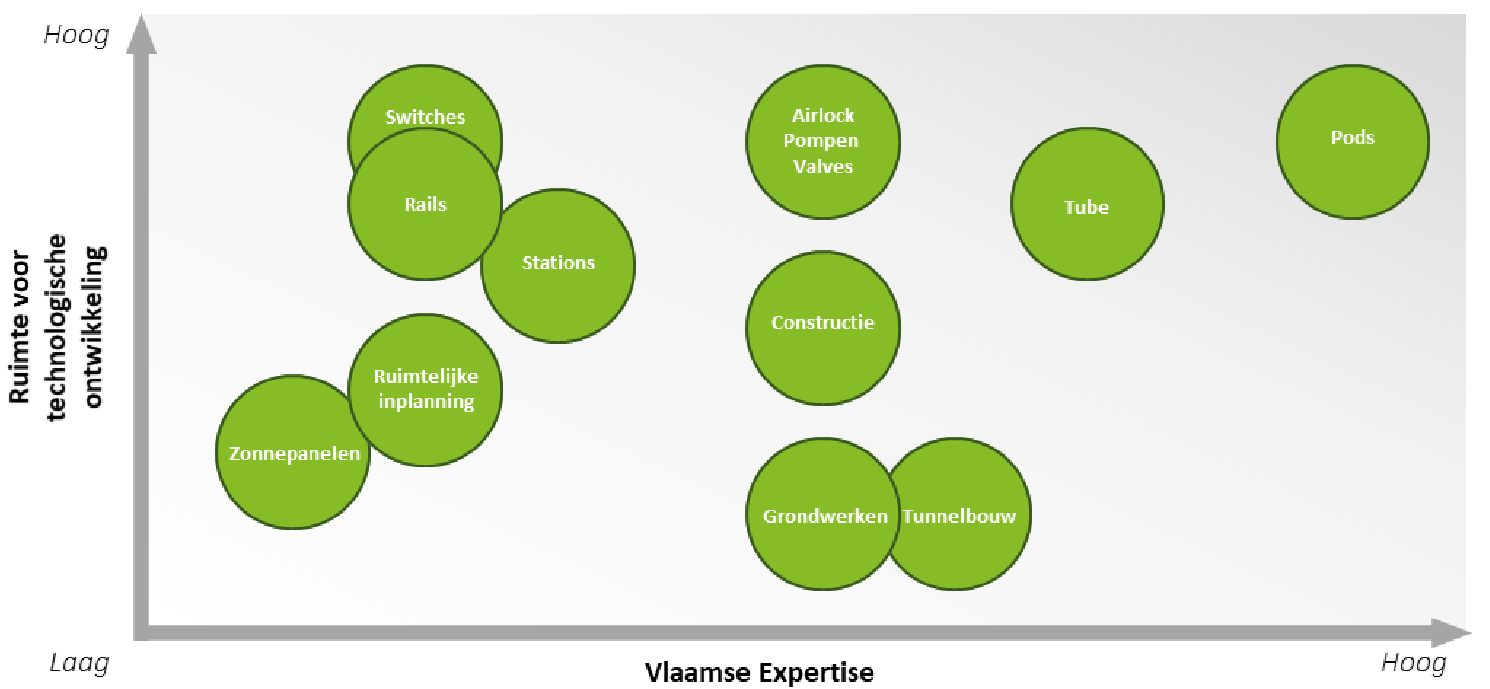
Pods appear to be a promising component for Flanders. The TRL for pods is relatively low, but their development is crucial for the hyperloop. Given the specific demands of the pods, such as high G-forces, dimensions, and vacuum transport, it would be challenging to transfer technology from other industries. Flanders has exceptional knowledge about composite materials, which could be used in pod design and construction.
The tube component is also of interest for Flanders. More research is needed to effectively build the tube, but Flemish companies could contribute. However, economic considerations might make the production of standard parts in Flanders less attractive, and the opportunity could lie more in precision parts and sub-components.
Further research is needed for the airlock, switch, pumps, and valves. Even though there could be some transferability of technology from other industries, these elements still need to be specifically developed for the hyperloop. Given Flanders' strong steel expertise, it could play a role in the research and production of these elements.
The construction of hyperloop stations will depend heavily on the development of other technologies. Flanders has the necessary companies to undertake this construction, but it does not have exceptional and distinguishing knowledge compared to foreign players. The same applies to tunnel construction and earthworks, where Flanders has sufficient expertise, but does not necessarily have a distinguishing position.
For rails and switches, more research is needed. At this stage, Flanders does not have exceptional expertise in this area. For the remaining components, there is neither a clear distinguishing expertise in Flanders, nor a great need for innovation.
In conclusion, Flanders appears best positioned to contribute to the development (and eventual production) of the pods, along with high-tech elements of the tubes, airlocks, pumps, and valves. Flanders has sufficient capacity for the concrete construction of a hyperloop trajectory, but it is unclear to what extent Flemish construction companies can contribute to the realization of global hyperloop networks.
Analysis of the worldwide and European context
This section of the document provides an analysis of the global and European context for the development of a European hyperloop network. The section highlights the need for collaboration at the European level, given the enormous challenges involved in implementing the hyperloop technology.
The summary outlines three key areas of focus:
- New Technologies: Significant technological development is needed to reach a commercial maturity level for the hyperloop system. Many initiatives in Europe and worldwide are already working on this.
- New Services: A new User Experience (UX) and service design are necessary for this novel mode of travel. Special service design is needed to ensure a pleasant experience for passengers in the completely enclosed pods.
- New Standards: The development of clear technical and safety standards is vital for ensuring safety and interoperability, and supporting the growth of the hyperloop industry.
Overview of relevant players
The document subsequently presents a comprehensive review of the global hyperloop industry, with an emphasis on the key players and their specific initiatives. It analyzes their current status, funding sources, target markets (either cargo or passenger), and geographic location.
Prominent American firms such as Virgin Hyperloop One and Hyperloop Transportation Technologies are especially highlighted due to their global media coverage and significant advancements in the field. Virgin Hyperloop One is underscored as the industry's leader, supported by substantial financial resources, numerous patents, and considerable progress in developing commercial routes.
The document also acknowledges other important contributors like Canada's TransPod and Netherlands-based Hardt Hyperloop. These entities, along with others, are briefly evaluated, offering insights into their tangible achievements and realistic future strategies. It's advised that a more thorough evaluation of these companies be undertaken, keeping in mind their individual accomplishments and strategic plans.
Initiatives towards standardization and regulation
To enable the realization of the hyperloop concept, a clear standardization is required. In 2018, four European hyperloop developers started a collaboration to develop common standards: Zeleros (Spain), TransPod (Canada & France), Nevomo (Poland), and Hardt Hyperloop (Netherlands). The collaboration aims to integrate standardization initiatives, develop common test infrastructure, and pave the way to hyperloop certification in cooperation with regulatory authorities and EU member states.
The benefits of this collaboration are to share the costs and risks of the standardization process, improve the hyperloop market position, foster cooperation between companies and EU institutions, and shorten the time-to-market. Given that a European hyperloop network will be transnational, it's essential to ensure the interoperability of the hyperloop systems for operational efficiency, safety, and comfort.
The four European hyperloop parties suggest that forming clear European standards, through the CEN/CENELEC framework, would be a good starting point. The first EU standards are expected to be realized in 2021. CEN and CENELEC bring together national standard-setting agencies from 34 European countries and provide a platform for developing European standards across various sectors. They work closely with the European Commission to ensure all standards comply with relevant EU legislation.
CEN and CENELEC also ensure consumer protection, product interoperability, and encourage transborder innovation. They involve industry federations, consumer organizations, environmental groups, and other societal stakeholders. Over 60,000 technical experts from industry and academia are involved in the work of CEN and CENELEC.
Once the EU standards are in force, all member states (and their companies) that market a hyperloop system or technology are advised to comply with these standards. The standard-setting process is initiated by the industry, with governments and industry providing their input. The resulting standards can then be used by a competent certification authority for certifying realized hyperloop systems. This regulation will likely be established by individual member states, with the EU adopting a locally established regulatory framework and implementing it throughout the EU.
Conclusion on European context
The market is currently largely dominated by North American initiatives, with Hyperloop One as the largest and most mature player. European players that emerged from university student teams, such as Hardt, Zeleros, Nevomo, and Continuum Industries, also play an important role. These European players began a collaboration in 2018 to develop common standards for a h network in Europe, with the goal of formally approving a first framework of EU standards by 2021. Countries that have built up relevant hyperloop expertise could contribute to this process in the coming years.
Current and future image of the Flemish transport landscape
This section provides a snapshot of the current and projected future state of the Flemish transport landscape, which is crucial to assess the potential impact of the hyperloop technology.
Passenger transport
In recent years, Belgium has seen a significant number of person-movements that is expected to grow due to demographic changes in the coming decades. Despite this growth, the average number of trips per person per week is predicted to remain consistent. The Federal Planning Bureau foresees the modal distribution of passenger transport to stay stable with passenger cars holding the majority share. However, emerging trends such as 'mobility-as-a-service' could potentially decrease the dominance of passenger cars in the future.
Cargo transport
More substantial growth is anticipated in freight transport, with the total volume of goods expected to increase by 27% by 2040 compared to 2015. Trucks are projected to continue dominating this sector, holding a 77% modal share in 2040. Despite efforts to increase the share of inland shipping and rail transport, their combined share in 2040 will remain limited.

Several critical technological developments could significantly impact the logistics sector by 2040:
- On-Demand Economy: The rise of e-commerce and online shopping is altering the transport needs for freight, shifting from bulk deliveries from regional distribution centers to retail locations to more diffuse deliveries to consumers' homes or offices. This shift demands an improved last-mile logistics system and faster delivery times.
- Physical Internet: The ongoing digitization of logistics processes is leading to the emergence of the 'Physical Internet', a hyper-connected global logistics system that allows seamless and open sharing of assets and the flow of goods. This development will allow for better coordination of different transport modes and more efficient package routing.
- New Modes of Transport: There's an increasing shift towards more efficient and environmentally friendly transport systems, with an expected rise in electric vehicles. By 2030, 20% of the Belgian fleet is expected to be fully electric. This shift will initially occur in urban areas due to the growing demand for 'last-mile' deliveries and the accompanying environmental impacts.
- Autonomous Transport: Autonomous technology is expected to significantly impact the transport sector, reducing costs associated with labor and increasing efficiency by reducing the need for stops. Widespread adoption of autonomous transport will require significant infrastructure adjustments and investment, and its timeline remains uncertain.
Potential hyperloop route in Flanders
This section will discuss the potential of implementing the hyperloop concept in Flanders. It will explore possible routes based on strategic criteria and identify a potentially attractive route. The chosen route will be used as a basis for a high-level impact analysis in the next chapter. However, it should be noted that this is not a complete feasibility study, but an initial exploration. Further research would be required to consider technical, spatial, and economic factors.
Possible routes for Flanders
This section discusses the potential hyperloop routes in Flanders, emphasizing their alignment with the Flemish Spatial Strategy for logistics and transport. Key elements of the Flemish logistics network include international logistics hubs (Brussels Airport and the seaports of Antwerp, Ghent, Zeebrugge, and Oostende), continental connections in the trans-European transport network, the Economic Network Albertkanaal, the Seine-Scheldt connection, and regional logistics hubs. Important elements of the Flemish network are shown in the figure below.
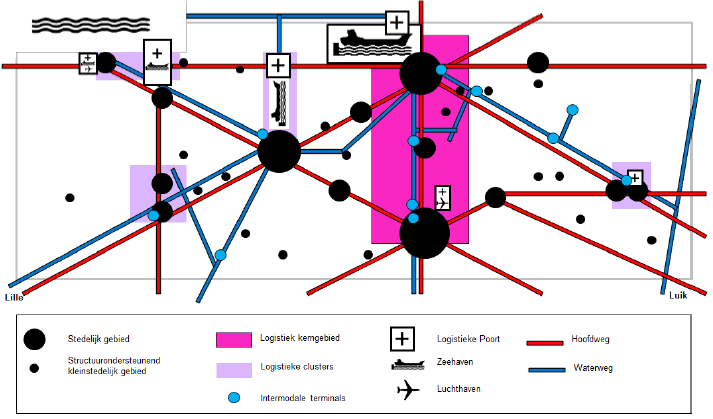
The Strategic Vision of the Flemish Spatial Plan identifies several priority policy lines. Their relevance for the hyperloop concept is discussed below:
- Potential Enhancement of International Hubs in Flanders: The hyperloop could serve as a supportive element in the growth of international nodes in Flanders, such as Brussels Airport and the seaports of Antwerp, Gent, Zeebrugge, and Oostende. The primary goal would be the potential connection of these pivotal international hubs, with a possible boost to both logistics and passenger travel.
- Possible Role in Developing Regional Logistics Hubs: While hyperloop might not focus as much on regional clusters such as the Economic Network Albert Canal, and the Brussels-Antwerp and Gent-Rijsel axes, there is potential for service provision to these nodes given geographic favorability. This could help in fostering the development of regional logistic nodes.
- Potential in Boosting the Territorial Performance of Hubs: Hyperloop could help enhance the territorial performance of nodes. There is potential for it to attract new logistics and industrial activities, thereby increasing job opportunities, augmenting the value per hectare, and fortifying circular economy systems and innovation within logistics and production activities.
- Possible Impact on Improving Quality of Life near Logistics Activities: The hyperloop could possibly help enhance the quality of life in regions near logistic activities. With a successful hyperloop route, there is potential for a decrease in road transport volume, development of logistic activities focusing on quality of life, and encouragement of stronger consolidation of logistic activities. This could work towards countering and possibly diminishing the scattering of such activities.
Within the context of this Flemish spatial strategy and current logistic structure, five potential routes have been identified (see figure below):
- Antwerp – Ghent-Zeebrugge: Connecting the three major Flemish seaports and the cities of Antwerp and Ghent.
- Antwerp – Ghent-Kortrijk: Connecting the ports of Antwerp and Ghent and the logistics cluster around Kortrijk.
- Antwerp – Genk/Hasselt: Connecting the port of Antwerp with the logistics cluster Genk/Hasselt (along the Albertkanaal).
- Antwerp – Brussels: Connecting Antwerp with Brussels (Airport and city area).
- 'Flemish Diamond' Loop: Connecting Antwerp, Brussels, and Ghent in a loop.

Evaluation of possible routes
Five potential routes have been identified and assessed based on their logistical capabilities, potential for passenger transport, alignment with Flanders' spatial strategy, and their prospective role in a cross-border hyperloop network. Based on these assessments, individual ratings for each route were created, these are provided in the subsequent table.
Routes | Logistics Transport: Route Potential | Passenger Transport: Route Potential | Strategic Fit | Cross-border Potential |
Antwerp – Ghent-Zeebrugge | + | - | + | - |
Antwerp – Ghent-Kortrijk | + | - | - | + |
Antwerp – Genk /Hasselt | + | - - | - | + |
Antwerp – Brussels | ++ | ++ | ++ | ++ |
'Flemish Diamond' Loop | - | ++ | - - | - - |
The first three criteria in the table above collectively provide an indicative portrayal of the 'Attractiveness for Flanders' of the routes. This 'Attractiveness for Flanders' can be plotted against the 'Fit in a European hyperloop network' (see figure below).
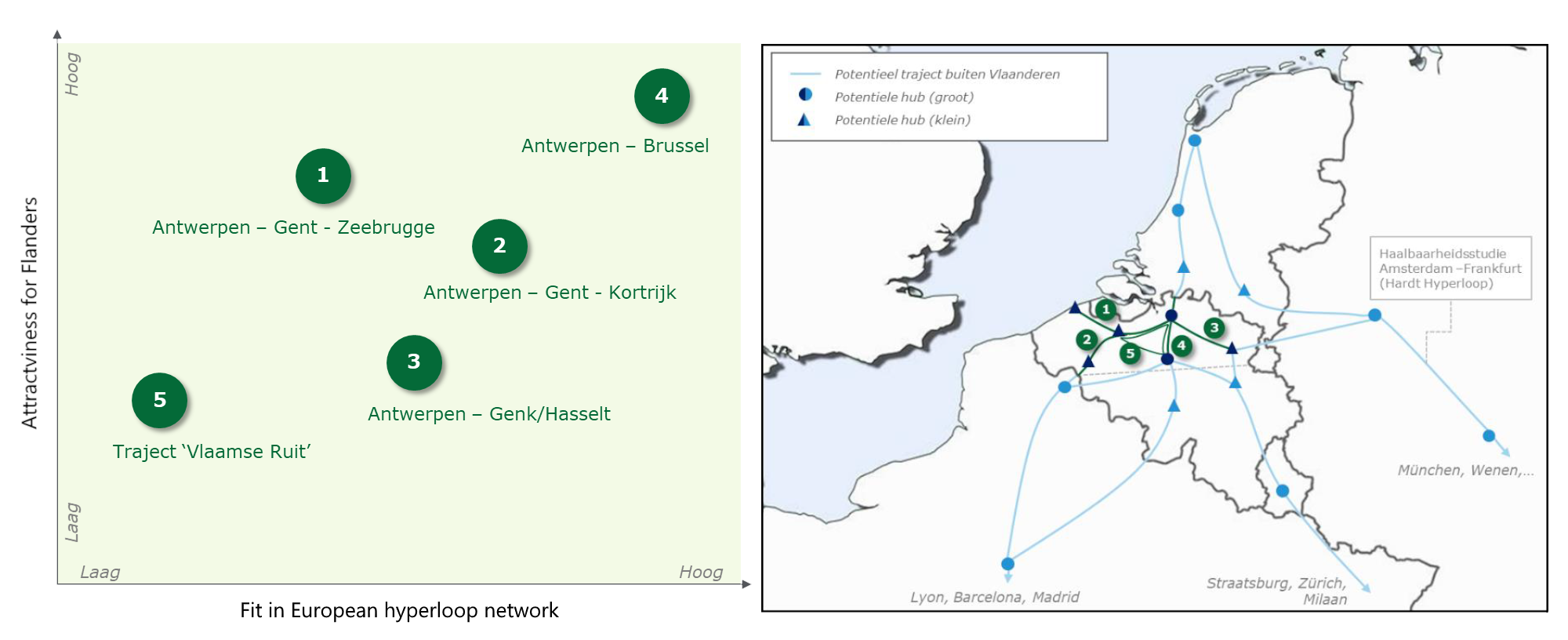
Based on the figure above the Antwerp - Brussels route currently appears to be the most relevant for Flanders due to its alignment with the Flemish spatial strategy and policy guidelines. It also seems to offer the best opportunity to position Flanders as an important node in a European hyperloop network, and to effectively unlock the Flemish core area within that network. Therefore, the further impact analysis in this report will focus on this route.
Impact
The Antwerp-Brussels hyperloop route is planned to be about 40km long with an additional 60km extending towards Amsterdam in the north and Paris in the south. The project involves the construction of two tubes to accommodate both passenger and non-containerized goods transport. Three terminals are to be set up in Antwerp, Mechelen, and Brussels. The top speed of the hyperloop is about 1200 km/h, while the average speed is expected to be around 500 km/h.
The introduction of the hyperloop is predicted to drastically reduce travel times. The journey from Antwerp to Brussels could potentially take as little as 6 minutes, which is 80% faster than the current train travel time. The entire route from Schiphol, Amsterdam, to CDG could be covered in just 61 minutes, a significant decrease from the current times by train and air.
The impact analysis of the hyperloop route in Flanders is divided into three sections. Firstly, it provides an estimate of the initial and operational costs of the hyperloop. Secondly, it assesses the direct impacts based on the potential shifts in transportation modes. Lastly, it outlines the indirect economic and spatial impacts of implementing a hyperloop route in Flanders.
Estimation of costs
The report dissects the cost estimate into two primary parts: investment costs and ongoing costs. The former primarily encapsulates the expenses for land allocation or repurposing, and significant infrastructural investment. This infrastructure could be non-renewable, like the construction of pylons, tunnels, tracks, and tubes, or renewable such as building pods, vacuum pumps, and switches. Factors influencing these costs include the route's distance, lifespan, desired diameter, positioning, and capacity.
On the other hand, recurring costs consist of financing costs and operational expenses. The financing costs hinge on elements like the lifespan, debt ratio, interest rate, and the remaining asset value. Meanwhile, operational costs encompass staff wages, passenger amenities, energy costs, and maintenance expenses. The size and number of hubs or stations within the network and the route's distance and passenger kilometers influence these costs.
An approximate cost calculation for the Antwerp-Brussels route has been presented, factoring in the above-mentioned cost components and assumptions. The initial investment for a 100 km route is estimated to be around €3.3B, with non-renewable infrastructure costs accounting for the majority. Additionally, the yearly operational cost is projected to be €170M, primarily comprising staff and maintenance expenses.
The report concludes by discussing possible financing models and business strategies, emphasizing that the exact cost structure and potential earning models would considerably depend on the choice of financing options, exploitation strategies, and pricing. A public-private partnership model is suggested as a potential capital structure, with the government focusing on industry support and innovation and private stakeholders driven by the promise of attractive returns. Nevertheless, a definitive decision regarding the business model and pricing strategy is deemed premature at this stage.
Direct impact of route
Below is an enumerated list summarizing the direct impacts highlighted in the report on the proposed hyperloop system between Antwerp and Brussels:
- Route Capacity: The capacity of a hyperloop route is strongly reliant on vehicle departure intervals. For this study, an interval of 2 minutes is assumed. The passenger pod is designed to hold up to 40 passengers, and a cargo pod can carry 12,000 kg. With an average operational activity of 95% over 20 hours per day, the route could potentially handle 15.64 million passengers or 4.99 million tons of cargo annually if used exclusively for one or the other. For a hyperloop system carrying both passengers and goods equally, an annual capacity of 8.32 million passengers and 2.5 million tons of cargo is anticipated. This capacity is flexible and could be adjusted according to societal needs and traffic volumes.
- Modal Shift of Passenger Transport: A potential shift from current modes of passenger transport such as flights, trains, and road vehicles towards the hyperloop system could be observed if the system offers competitive pricing and efficiency. Flights could be most affected with an estimated 90% shift due to the faster speeds and more frequent departures that hyperloop could offer. Train traffic could see a 70% shift due to hyperloop's potential to be 75% faster than current high-speed trains. Road traffic might be least affected with an estimated 8% shift as not all drivers can or will wish to switch modes.
- Modal Shift of Freight Transport: The hyperloop, with its high-speed potential, could substantially alter freight transport, especially air freight. Currently, only 27,000 tons of goods are moved between top European cargo airports like Paris CDG, Schiphol, and Brussels Airport. However, the hyperloop could attract additional logistics activity near these airports, thus increasing volumes. Moreover, it could replace a substantial portion of truck transport, which constitutes 80% of all freight transport. Given the hyperloop's cargo capacity of an estimated 2.5 million tons, it's feasible that about 8% of the current freight volume on the Antwerp-Brussels axis, which totals 31.2 million tons, could shift to the hyperloop.
- Volume Impact: An analysis of a potential hyperloop route between Antwerp and Brussels in Flanders indicates it could fully utilize its capacity in the long term. The total volume of travelers and goods combined would be equally split at 50% each, replacing 1.53 million people from aviation, 3.85 million from high-speed train transport, and 2.49 million from road traffic. Similarly, it would replace 27,000 tons from air freight and 2.473 million tons from road freight.
- Time-saving Impact: The implementation of a hyperloop in Flanders could result in significant time savings for both personal and cargo transport. For personal transport, the estimated annual value of time saved is around €62.37M. For cargo transport, the estimated annual value of time saved is approximately €9.44M. These figures are derived from assessing the 'willingness-to-pay' for time saved across different transport modes.
- Energy Consumption: The hyperloop, using an average of 27 Wh per passenger per kilometer, is theoretically far more energy-efficient than existing transport modes, from being twice as efficient as train transport to 30 times as efficient as aviation. This high energy efficiency could reduce the energy consumption of transport in Flanders, with a total energy consumption reduction of 520.1 GWh due to shifts from existing modes to the hyperloop. This is a reduction of 0.9% compared to the current total energy consumption of the transport sector in Flanders.
- CO2 Emissions: Building a 100-kilometer hyperloop route in Flanders would result in an additional, one-time CO2 emission of 900,000 tons. However, the hyperloop could significantly reduce ongoing emissions, with an average of 12g of CO2 per passenger per kilometer, compared to 199g for aviation, 115g for road transport, and 18g for trains. Based on a projected modal shift to hyperloop, this could reduce CO2 emissions by about 136,599 tons per year or about 0.8% of the Flanders transport sector's annual emissions of 16 million tons. At predicted 2040 values for European CO2 certificates, the CO2 savings could amount to €9.6M per year, offsetting the initial emissions within seven years. These reductions could be even greater if the proportion of renewable energy sources in the electricity production mix increases.
- Alleviation of Existing Infrastructure: The proposed hyperloop can help alleviate the pressure on existing transport infrastructures. By attracting a significant portion of passenger and freight traffic, the hyperloop could reduce the volume of traffic on highways and the number of flights between major cities. This shift would not only lessen wear and tear on infrastructure but also potentially decrease traffic congestion and noise pollution. However, the specific impacts would require a more detailed analysis, considering the capacity of the existing infrastructure and various other indirect factors.
Indirect impact of route
In addition to the direct impacts described above related to a potential implementation of the studied hyperloop route, there are also numerous conceivable indirect impacts. Given the complexity and uncertainty around the precise magnitude and quantification of these effects, what follows is a descriptive overview of possible indirect impacts.
- Economic impact: The implementation of the hyperloop could indirectly stimulate the Flemish economy and employment by generating significant value, especially if local industries participate strongly in construction and technological development. The necessary hubs or stations could encourage the formation of innovative high-value clusters of technology-focused businesses and logistic players. It's estimated that a hyperloop route's development and operation could create approximately 300 full-time jobs, however, this preliminary estimate requires further detailed analysis.
- Spatial integration: The spatial integration of a hyperloop route in Flanders will present a significant challenge due to its densely populated and developed nature. Issues include complexity in property rights, obstacles in existing infrastructure, proximity to residential areas, and the need for efficient multimodal passenger and cargo access. The success of this venture will greatly rely on political influence, social willingness, and potentially additional investments in multimodal transport infrastructure. Ensuring effective connection options to city centers will be crucial for the hyperloop to serve as an attractive commuting and tourism alternative.
- Societal impact: The hyperloop route's societal impact could change perceptions of accessibility due to greatly reduced travel distances, potentially influencing residential choices and accessibility to the job market. However, the system's theoretical capacity may limit usage primarily to a select few rather than mass commuting. Also, the introduction of hyperloop could affect the housing market by increasing the appeal, and possibly property values, of certain cities or districts. The government will need to guide discussions about designing for less mobile individuals and sustainably managing peak demand that exceeds capacity.
Legal barriers
To date, there has been limited emphasis on legislation for the rollout of the hyperloop. Nonetheless, several key legal obstacles or barriers can be identified. Like other large and cross-border infrastructure projects, the complex spatial integration will bring challenges in the areas of spatial planning and urban development. The creation of a hyperloop route will necessitate possible planning changes and permits, where complaints and/or appeals can significantly prolong the approval process. The so-called 'Not in my back yard' sentiment will undoubtedly play a strong role, which is further reinforced by the current knowledge gaps. The precise impact on the environment cannot be exactly estimated, for example, due to a lack of knowledge about the noise that the hyperloop will generate.
Given the technical specificity of the hyperloop – requiring a straight route and ideally specific stations for efficient transfers – there appears to be no immediate use of existing easements (for significant parts of the route). Expropriations and the establishment of new public utility easements for the route's construction will also take time and require compensation.
In terms of mobility, interoperability, and safety, there is a need to develop standards and a separate set of rules for this new mode, and there are points of attention regarding liability. Especially in the case of passenger transport, the safety of the hyperloop must be guaranteed at all times. This applies equally to passenger test drives. European safety standards are, therefore, a first crucial step. In addition, one must also be armed with a crisis plan in case of accidents.
While the process of achieving European standardization has started, it will take a few more years. Especially in the case of an autonomous driving hyperloop, it can be expected that other liability systems than the classic fault liability will gain importance, such as product liability.
The need to adapt current legislation seems evident, but to date, it seems limited to the hyperloop test area in the Netherlands, for example. Based on this legislation, deviations from the building technical regulations are possible, as well as deviations from the obligation to obtain an environmental permit. However, for the actual construction of an entire route, one cannot simply resort to rule-light or experimental regulation. The erosion of basic rights must be avoided. In addition, the actual amendment of the legislation seems to be relevant only when, for example, European standards have been developed. Close monitoring of this in the short term is advisable, as well as further developments in other countries.
Roadmap and policy advice
The hyperloop has the potential to significantly impact passenger and freight transport in Flanders and strengthen the strategic position of Flemish cities and logistics hubs within Western Europe. The recommendations in this chapter are framed based on several key insights:
- Flanders possesses specific relevant industrial and research competencies, but there is currently limited to no activity in the hyperloop concept within the region.
- The concept offers theoretical concrete advantages as a faster and more efficient alternative to existing transport modes. However, effective commercialization on a large scale is still about 10 years away, leading to uncertainties in areas like costs and regulations.
- The implementation of a hyperloop route in Flanders is only feasible within a broader European cross-border context. Flanders positions itself as a logistics center and a gateway to and from Europe due to its favorable location and well-developed infrastructure. To sustain this attraction for national and international industrial investments in Flanders, it must ensure that it is viewed as a strategic part of the European network (avoiding being bypassed when the technology becomes mature enough for West European implementation).
- Flanders faces greater challenges in spatial planning and investment compared to other countries due to high population density, fragmentation, and differing priorities in transport infrastructure.
- Some European countries are ahead of Flanders in hyperloop development, benefitting from the presence of private enterprises working on the hyperloop. Examples include the Netherlands and France, which already have hyperloop test facilities and expansion plans.
Given these reasons, a "Technology Mover" strategy seems appropriate, focusing on contributing to the development of hyperloop components where Flanders has strong industrial capacity and academic knowledge. In the short term, the construction of (test) infrastructure is left to other countries due to high costs and the need for sustainable political support at the highest level. Additionally, other countries are already further ahead in this aspect, making it strategically less valuable for Flanders at present.
The "Technology Mover" strategy allows Flanders to make important "no-regret moves" in the short term with limited financial risk and be ready for more significant investments when the concept becomes more mature in the long term. However, it is essential to initiate concrete actions in Flanders in the short term to avoid strategic disadvantage compared to neighboring regions and countries. Flanders must actively engage in knowledge and product/service development to play a role within a potential European network.
The report suggests recommendations for Flanders in three time horizons:
Short Term (0-6 months):
- Integrate the intention to further research and follow up on the hyperloop concept into policies, recognizing its potential for both the public and private sectors.
- Support Flemish universities and research institutions in exploring the hyperloop concept and their potential contributions. Encourage student teams' participation in international hyperloop competitions.
- Appoint a responsible theme manager to systematically monitor the technical and commercial development of the hyperloop concept and initiate activities to familiarize industries and research institutions with the concept.
- Coordinate with industry and relevant logistics players to raise awareness about the potential of the hyperloop.
Mid-Term (6 months - 5 years):
- Support the development of the hyperloop ecosystem in Flanders through funding and subsidies and gradually eliminate regulatory barriers.
- Participate in European discussions about standardization and the potential establishment of a European cross-border hyperloop network, advocating for Flanders' interests and attractiveness within this network.
- Conduct a detailed technical and economic feasibility study for a hyperloop in Flanders, possibly in collaboration with neighboring regions and countries.
Long-Term (+5 years):
- Establish an agency for hyperloop development in Flanders to monitor advancements, connect with foreign governments and players, define a Flemish strategy, and translate it into impact studies and legislative recommendations.
- Build and operate a hyperloop route if it proves feasible and advantageous, based on the established strategy.
The roadmap provided in the report summarizes the recommendations for Flanders' involvement in the development of the hyperloop concept.
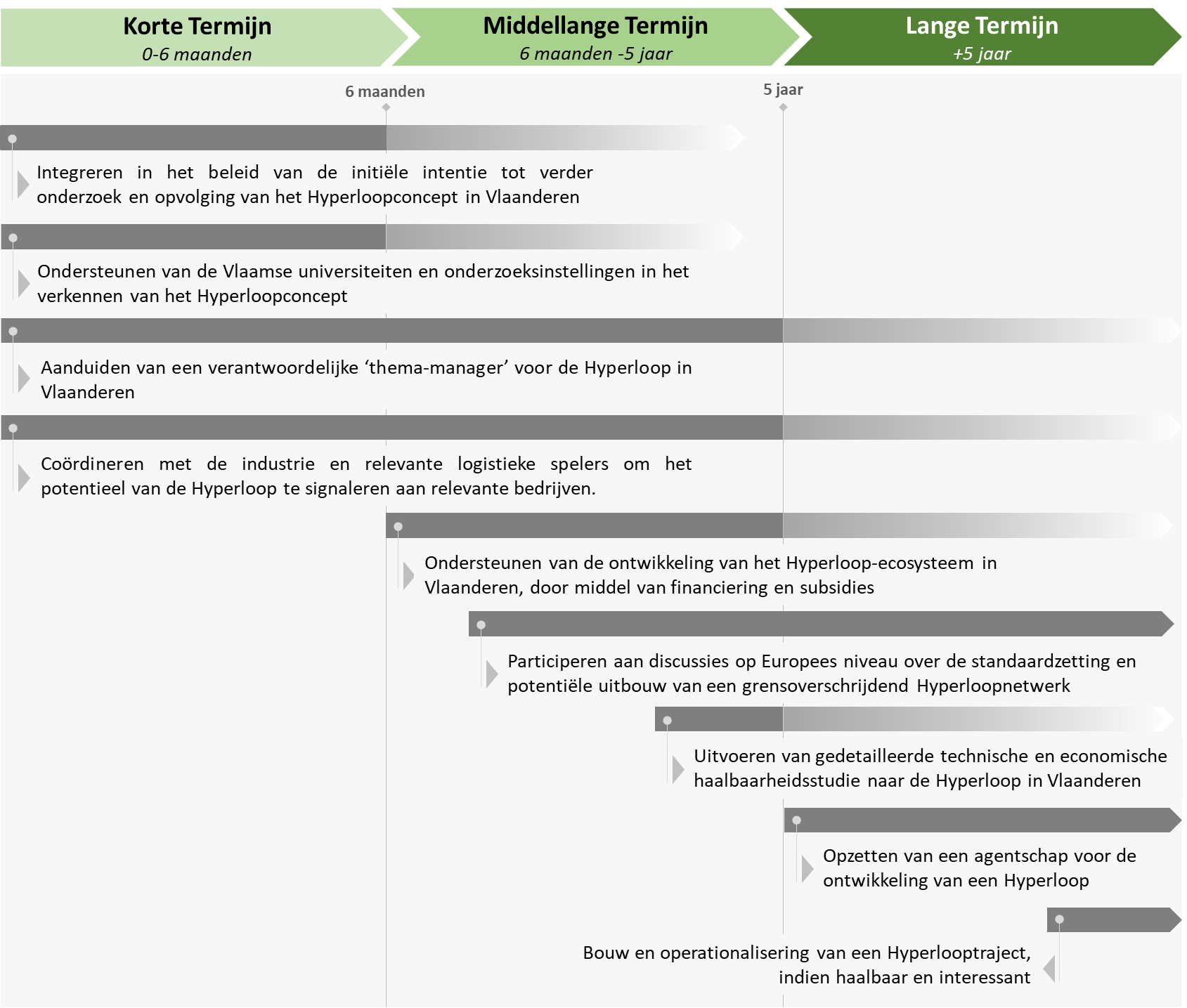
Acknowledgements



This study was conducted by Deloitte, Antwerp Management School, and VIL Empowering Logistics in collaboration with Hardt Hyperloop.

Vlaanderen ziet toekomst in transport via hyperloop | Agentschap Innoveren en Ondernemen
https://www.vlaio.be/nl/nieuws/vlaanderen-ziet-toekomst-transport-hyperloop
